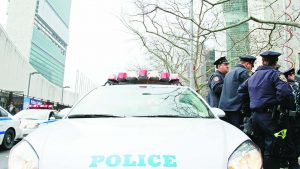by R.K. Campbell | Contributing Editor

NYPD officers stage their vehicles in front of United Nations Headquarters, preparing for a counter-terrorism drill.
The “Lone Wolf” attacks we have seen during the past few years have been called a leaderless Jihad. This is essentially correct. From the Boston Bombers to the attacks in Orlando we are seeing those with mental illness to one degree or another, marginality, and difficulty sustaining relationships, who have been cyber radicalized. The problem of cyber radicalism is a current one that sees no signs of abatement.
The discussion could go off on tangents but just as very few children that play Grand Theft Auto have a desire to go out and steal a Chevy truck and fight with the police, it only takes one to bring about a tragedy. The effectiveness of counter terrorism has been such that very few major attacks have reached the operational stage. The Patriot Act and forming of the Department of Homeland Security in 2003 have made America a much safer place.
Due to vigilance the Internet has been more of a breeding ground for terror than clandestine meeting places have. The problem is that as the issue of identity theft has risen not only criminals but honest citizens and banks have developed new technology to encrypt information. This makes the problem of monitoring communication between criminals more difficult. It is rightly so we developed technology to maintain privacy as the threats to our livelihood and savings are very real. But covert communication is very important to the terrorists and they will use this technology to cover their tracks.
The radicals that use face to face communication are becoming increasingly rare. The limited scope of this face to face communication means that the internet communication may in fact be one sided. The person that is radicalized may not make his master aware of this recruitment until after an attack has transpired. In the past our own neo-Nazi group leaders and others were careful not to use language that would leave them open to an incitement to violence charge or accessory charge. Those living outside of the country have no such reluctance to promote violence and no concerns.
The looser and more decentralized a confederation the more difficult to pinpoint and detect. Those individuals likely to be radicalized seem to have a shared narrative. Seldom have they endured true hardship but they are able to rationalize some wrong or shortcoming of their own as a justification to inflict human death and suffering upon an innocent population. The hierarchal model for radicalization is outmoded, at least in developed countries. Rather the person that becomes radicalized is able to bypass the legitimate news media and go to other sources for information. This person supports the enemies of the United States and while a large portion of the population may have the same belief and attitude as well few act upon it. Major Nidal Malik Asan was radicalized and acted upon this evil vision at Fort Hood, TX. Adam Gadahn acted in Boston. These men were in contact with like-minded individuals, but not personal contact. They were living in the real world but the digital world was their most meaningful experience due to their inadequate personalities. Radical Islam was for them a rationalization for murder and even death or suicide.
The problem is, of course, how much surveillance and intrusion we are willing to accept in our daily lives to detect and capture these criminals. Most Americans want no intrusion and no limits on liberty. I am four square American in this regard. We are not akin to the United Kingdom and other areas where privacy and freedom are more aspirational than operational. Ask the Irish jailed for non-violent dissension; we do not wish to reach that point and we will not as long as we are vigilant. There is a well-reasoned standpoint that everything isn’t subject to analysis and some things cannot be completely understood or monitored. The reality is that we are winning the war on terror on the home front and the organized terror attack is far less likely than an organized full scale attack. (The likelihood is low, the possibilities remain endless however.)
The lone wolf attacker is the threat that the individual armed citizen is most likely to face and the one threat that we have the ability to address and defeat.
The best plan is always to call first responders. We have to give them credit; in most of the recent events they have arrived quickly and went in shooting and confronted the threat quickly rather than standing back and allowing the victim numbers to mount. But the person on the point that is able to counter such an attack should. Those operating under color of law and that have institutional backing have fewer worries. If you are carrying in an area where it would perhaps be stupid not to— but it is a less permissive area—you are in muddy water. If you are in the People’s Republic of New Jersey you are far less likely to be commended than if you are in the great state of Texas. Just stating the facts; there are good people everywhere but not good government.
How fit you are and how well armed you are is also a factor. I do not think anyone in their right mind believes they have much chance of success against a rifle if they are armed with a pocket pistol. It is pretty easy to decide to intervene actually. We all know what an active shooter situation is. It isn’t a personal fight, it isn’t a take-over robbery. It isn’t intervening over someone else’s money. It is about saving lives and perhaps saving many lives. Know the adversary, be informed and know what the likelihood of terror attacks now look like in America.



